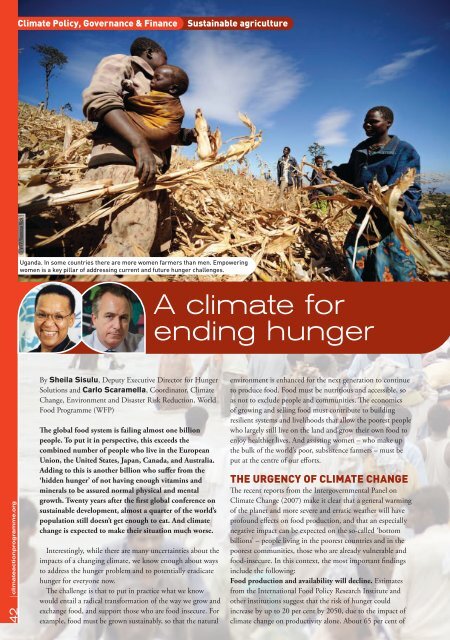Climate Action 2011-2012
You also want an ePaper? Increase the reach of your titles
YUMPU automatically turns print PDFs into web optimized ePapers that Google loves.
climate Policy, governance & finance<br />
Sustainable agriculture<br />
© WFP/Vanessa Vick<br />
Uganda. In some countries there are more women farmers than men. Empowering<br />
women is a key pillar of addressing current and future hunger challenges.<br />
A climate for<br />
ending hunger<br />
42 climateactionprogramme.org<br />
By Sheila Sisulu, Deputy Executive Director for Hunger<br />
Solutions and Carlo Scaramella, Coordinator, <strong>Climate</strong><br />
Change, Environment and Disaster Risk Reduction, World<br />
Food Programme (WFP)<br />
The global food system is failing almost one billion<br />
people. To put it in perspective, this exceeds the<br />
combined number of people who live in the European<br />
Union, the United States, Japan, Canada, and Australia.<br />
Adding to this is another billion who suffer from the<br />
‘hidden hunger’ of not having enough vitamins and<br />
minerals to be assured normal physical and mental<br />
growth. Twenty years after the first global conference on<br />
sustainable development, almost a quarter of the world’s<br />
population still doesn’t get enough to eat. And climate<br />
change is expected to make their situation much worse.<br />
Interestingly, while there are many uncertainties about the<br />
impacts of a changing climate, we know enough about ways<br />
to address the hunger problem and to potentially eradicate<br />
hunger for everyone now.<br />
The challenge is that to put in practice what we know<br />
would entail a radical transformation of the way we grow and<br />
exchange food, and support those who are food insecure. For<br />
example, food must be grown sustainably, so that the natural<br />
environment is enhanced for the next generation to continue<br />
to produce food. Food must be nutritious and accessible, so<br />
as not to exclude people and communities. The economics<br />
of growing and selling food must contribute to building<br />
resilient systems and livelihoods that allow the poorest people<br />
who largely still live on the land and grow their own food to<br />
enjoy healthier lives. And assisting women – who make up<br />
the bulk of the world’s poor, subsistence farmers – must be<br />
put at the centre of our efforts.<br />
The urgency of climaTe change<br />
The recent reports from the Intergovernmental Panel on<br />
<strong>Climate</strong> Change (2007) make it clear that a general warming<br />
of the planet and more severe and erratic weather will have<br />
profound effects on food production, and that an especially<br />
negative impact can be expected on the so-called ‘bottom<br />
billions’ – people living in the poorest countries and in the<br />
poorest communities, those who are already vulnerable and<br />
food-insecure. In this context, the most important findings<br />
include the following:<br />
Food production and availability will decline. Estimates<br />
from the International Food Policy Research Institute and<br />
other institutions suggest that the risk of hunger could<br />
increase by up to 20 per cent by 2050, due to the impact of<br />
climate change on productivity alone. About 65 per cent of












